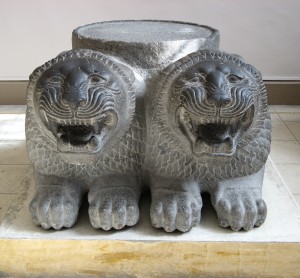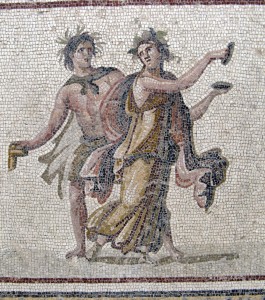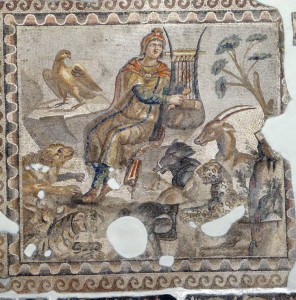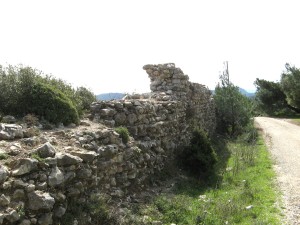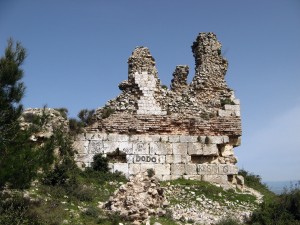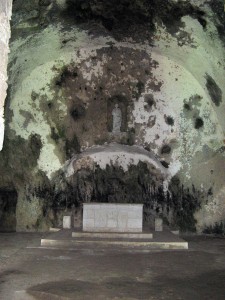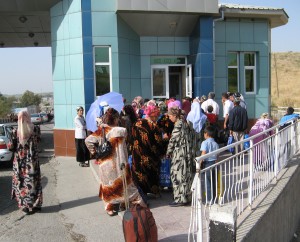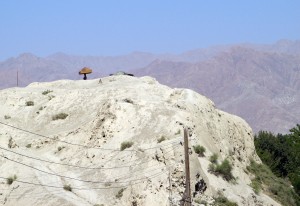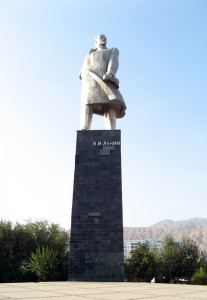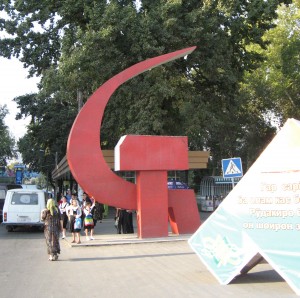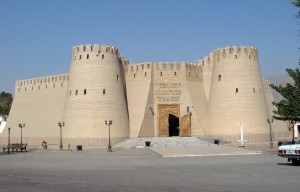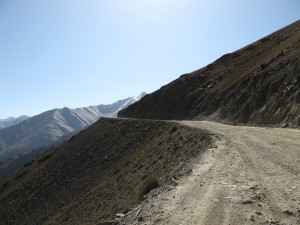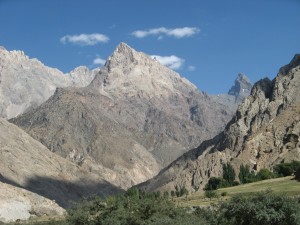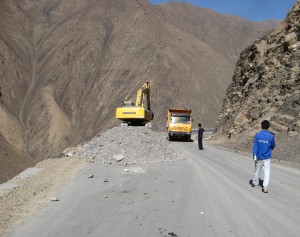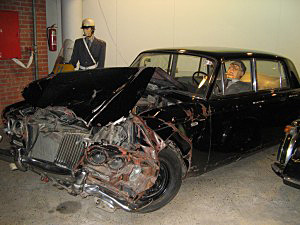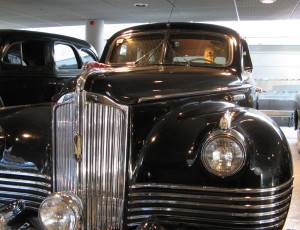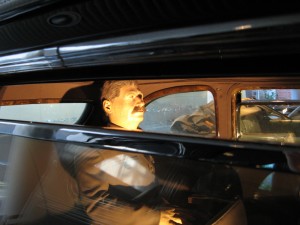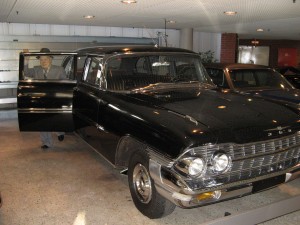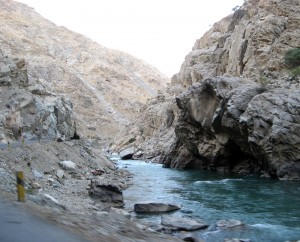 We came down through the Salang Pass from Mazar, and then drove up a surprisingly good road to the Panjshir valley. The entry to the valley is an extremely defensible narrow gorge between steep cliffs.
We came down through the Salang Pass from Mazar, and then drove up a surprisingly good road to the Panjshir valley. The entry to the valley is an extremely defensible narrow gorge between steep cliffs.
The Panjshir Valley was the great stronghold of the mujahideen in their battle against the Soviets, and there are frequent remains of wrecked Soviet APCs and the occasional tank in the lower valley. This is a Tajik area, vibrantly loyal to the memory of their beloved commander Moussad, the Lion of Panjshir, and deeply hostile to Pashtuns (and thus to Taliban). It’s probably as safe a place as you can get in Afghanistan right now.
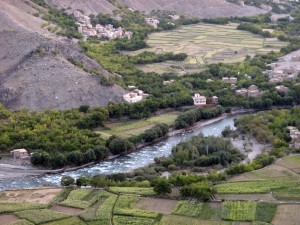 We supposedly had permission to stay at the elegant new Government Guesthouse. However there was a lengthy dispute over whether we would be allowed in or not. After some toing and froing between our guide and the police post and the security service post, and a long altercation with the guesthouse staff we were finally, reluctantly, admitted. (This did mean we got to enjoy the fine views of the valley from up at the Security Service command post.) The guesthouse is generally very comfortable, but electricity was erratic and the showers healthy and cold.
We supposedly had permission to stay at the elegant new Government Guesthouse. However there was a lengthy dispute over whether we would be allowed in or not. After some toing and froing between our guide and the police post and the security service post, and a long altercation with the guesthouse staff we were finally, reluctantly, admitted. (This did mean we got to enjoy the fine views of the valley from up at the Security Service command post.) The guesthouse is generally very comfortable, but electricity was erratic and the showers healthy and cold.
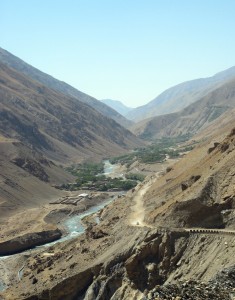 Next morning, we drove up the valley using the new road. This is still under active construction and while the lower part is tarmac, the upper part is still a dirt road. Eventually this road will be extended through the Wakhan corridor all the way to China. (Wow!) Due to a detour, we had to splashily ford the Panjshir river at one point. We drove to the current road-head in the Parian (upper valley) and stopped for a picnic lunch.
Next morning, we drove up the valley using the new road. This is still under active construction and while the lower part is tarmac, the upper part is still a dirt road. Eventually this road will be extended through the Wakhan corridor all the way to China. (Wow!) Due to a detour, we had to splashily ford the Panjshir river at one point. We drove to the current road-head in the Parian (upper valley) and stopped for a picnic lunch.
The valley is extremely scenic, a green ribbon caught between the stark Hindu Kush mountains, sometimes only a narrow canyon, but sometimes broadening out to green fertile farmland, sometimes with rice fields, but always still squeezed between the dark barren hills.
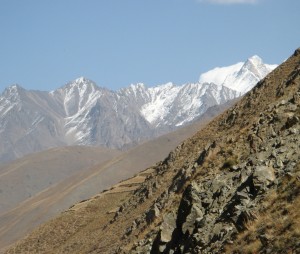 At lunch, several Afghans from the road building team came over and chatted with us. They were very convivial, joking and laughing, with our guide as interpreter. As part of the conversation, people asked about our families, discussed how many children they themselves had, etc. One man, with a fine bushy black beard was introduced to us as having five wives and 14 children. He looked rather sheepish. His co-workers were nodding and chuckling. Eventually it was revealed that they were in fact teasing him, as he was about to take the slightly unusual step of marrying a second wife (and not a fifth!).
At lunch, several Afghans from the road building team came over and chatted with us. They were very convivial, joking and laughing, with our guide as interpreter. As part of the conversation, people asked about our families, discussed how many children they themselves had, etc. One man, with a fine bushy black beard was introduced to us as having five wives and 14 children. He looked rather sheepish. His co-workers were nodding and chuckling. Eventually it was revealed that they were in fact teasing him, as he was about to take the slightly unusual step of marrying a second wife (and not a fifth!).
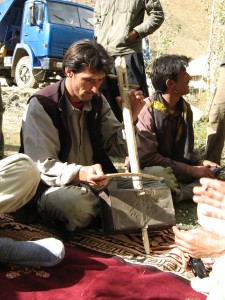
Improvised ghaychak
The road workers occasionally hold impromptu night time concerts, where they use their trucks to provide light; play music and dance. They brought over their home-made ghaychak instrument and demonstrated it for a little. Alas, with my croaky tone-deaf voice I dared not reciprocate!
As we returned down the valley, we hit an unexpected snag. A team was dynamiting the rock above the road to widen it and men were then crowbarring free the loosened rock onto the road. However, the excavator that was supposed to remove the fallen rock had developed a flat tire, so broken rock had accumulated, blocking the road. Fortunately there was only a short pause while they replaced a wheel and then cleared the road.
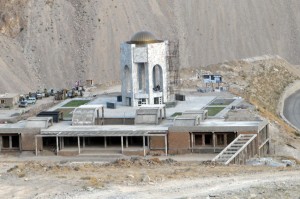
The following morning we visited Massouds’s Tomb. The tomb building itself is quite elegant, on a striking location, with a fine view over one of the most fertile sections of the valley. A large culture centre is being built around the tomb. There is also a wrecked tank and several APCs as a kind of informal additional memorial.
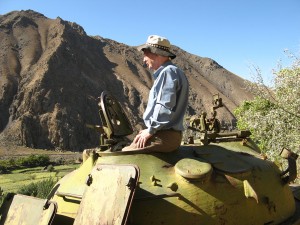 A little further down the valley, we stopped at a well preserved Soviet tank. It had a small gash in the turret, running all the way through, which is presumably from the rocket that killed it. I was able to clamber around inside – it was actually more spacious than I had expected for Soviet gear.
A little further down the valley, we stopped at a well preserved Soviet tank. It had a small gash in the turret, running all the way through, which is presumably from the rocket that killed it. I was able to clamber around inside – it was actually more spacious than I had expected for Soviet gear.
Note: This trip was part of a private tour arranged through Great Game Travel of Kabul. Afghanistan isn’t always a safe destination at the moment, and I’m grateful to Great Game for their good sense and continual kind guidance throughout.
